settings
children
With Famly since
If we forget about what it feels like to step on it when it’s 3 AM, dark, and you left your slippers upstairs, it really is hard to think of a downside to LEGO. And yet the benefits are countless.
From reinforcing fine motor skills and encouraging imagination to introducing maths and engineering, here are some fun and educational activities for the kids in your nursery.
1. Listening Game

The activity – Homemade Lego Listening Game by Stories and Children
EYFS area(s) – Communication & Language; Personal, Social & Emotional Development
In a nutshell – Put simply, it’s a 3-D version of the classic Battleship game. Sit your little ones in pairs facing each other and encourage them to arrange their blocks in a pattern. Then challenge their partners to recreate it. The catch? They can’t see each other’s designs and have to rely on verbal instructions!
What you need:
- LEGO or Duplo Blocks
- A Cardboard Box
2. Ring Toss
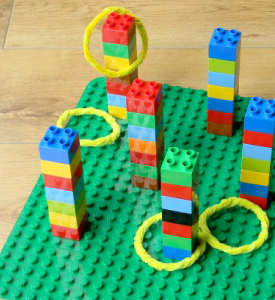
The activity – LEGO Duplo Ring Toss by Stir the Wonder
EYFS area(s) – Physical Development (Fine & Gross Motor Skills)
In a nutshell – Children stack some bricks into towers, twist pipe cleaners into rings and they’re ready for a tournament! They can take turns tossing the rings onto the towers individually or in groups. As well as being great for physical development, you can leave the job of counting the score to your little learners and get even more out of this activity.
What you need:
- Duplo Plate
- Duplo Bricks
- Pipe Cleaners
3. Duplo Math
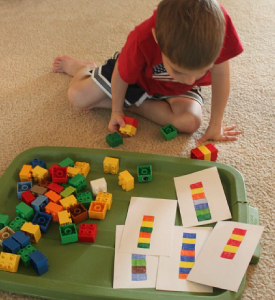
The activity – Two Preschool Math Activities With Duplo Legos by Frugal Fun 4 Boys and Girls
EYFS area(s) – Mathematics
In a nutshell – Maths is a lot much more fun when combined with building. Write down a number and let kids put them in order. Next, they try to create towers with the corresponding total number of bricks. If your little ones are not ready for counting yet, try the second activity where they can observe patterns in tower drawings before recreating them with bricks.
What you need:
- LEGO or Duplo Bricks
- Colourful Pens
- Paper
4. Learning Letters
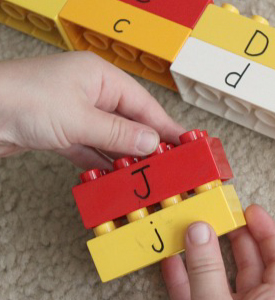
The activity – How to Teach the Alphabet With Lego Duplo Blocks by Pre-K Pages
EYFS area(s) – Literacy
In a nutshell – Once connecting the blocks together isn’t too much trouble for little hands, step it by writing lower and upper case letters on the sides of the bricks. Then, let the kids find the matching parts or even create some simple words.
What you need:
- LEGO Blocks
- Pens
5. LEGO Painting
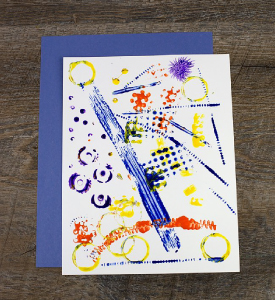
The activity – Lego Painting for Kids by Kids Activities Blog
EYFS area(s) – Expressive Arts & Design
In a nutshell – While it’s definitely too soon to introduce kids to the concept of cubism, it’s absolutely fine to start practicing it! Gather a range of blocks and show them how to dip them in the paint before stamping or pressing them onto a piece of paper to create abstract combinations.
What you need:
- Paint
- LEGO
- White Paper
- Paper Plate
6. Playdough Minifigures
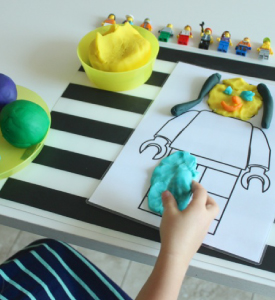
The activity – Play Dough LEGO Minifigures by Mama Papa Bubba
EYFS area(s) – Physical Development (Fine Motor Skills)
In a nutshell – A small detour away from the blocks. Print the LEGO man outlines and check out what figures you have lying around your setting. Hand some play dough to kids and let them choose their favourite character. This activity requires some serious fine motor skills so first show your little ones how to soften and mould the dough to fill in different parts of the figure’s body.
What you need:
- Playdough
- LEGO Figures
- Free Printables
7. LEGO Storytelling

The activity – Lego Inspired Story Retelling of the Very Hungry Caterpillar by The Educators’ Spin On It
EYFS area(s) – Communication & Language; Understanding the World; Literacy
In a nutshell – Children listen to you reading a story and then recreate the scenes with LEGO bricks. Now, brace yourself a little bit, this activity requires a lot of time, patience and imagination. But it’s all worth it, with its versatile impact on kids’ development and hours of fun and exploring creativity.
What you need:
- Any Children’s Book
- LEGO Bricks
8. How Many LEGOs Long

The activity – How Many LEGOs Long by Playdough to Plato
EYFS area(s) – Mathematics
In a nutshell – Here’s a fun way to work on measurement. Collect some toys and ask kids how many bricks they think they need to match the item’s length. Then lay a line of LEGO out to test their guesses. Once they get the hang of it, encourage your little learners to weigh each other up and test it on their own.
What you need:
- LEGO Bricks
- Tape
The big ideas
Please note: here at Famly we love sharing creative activities for you to try with the children at your setting, but you know them best. Take the time to consider adaptions you might need to make so these activities are accessible and developmentally appropriate for the children you work with. Just as you ordinarily would, conduct risk assessments for your children and your setting before undertaking new activities, and ensure you and your staff are following your own health and safety guidelines.
Get 1000s of free EY activities
Want over 7,000 activities? See them in a free 14-day trial. Filter to target learning areas, age groups and topics, and get inspired.
Get started









